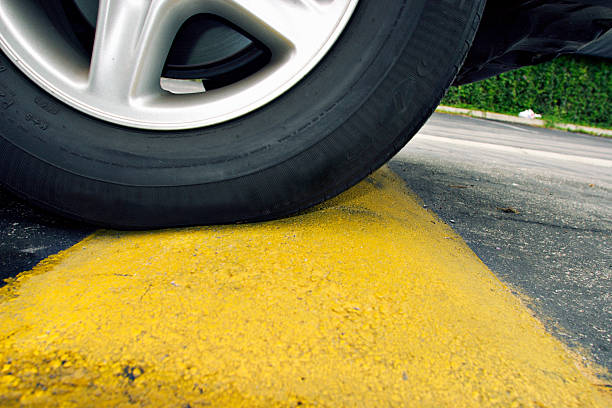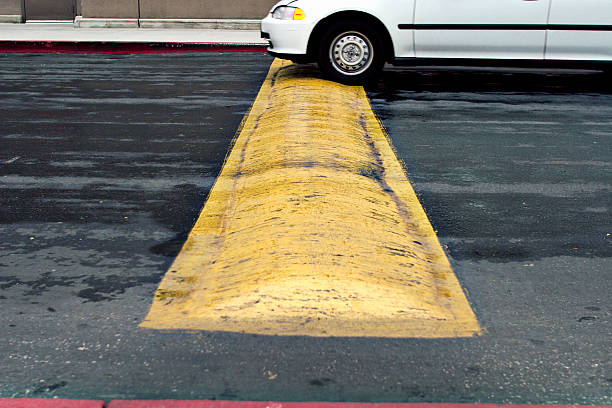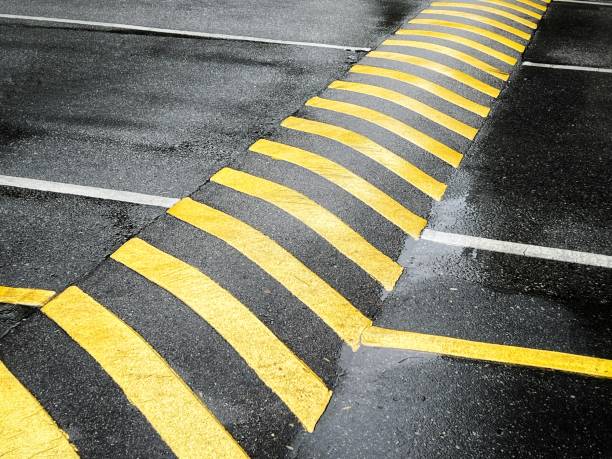Top Benefits of Using Speed Bumps for Asphalt Roads
Speed bumps are effective traffic calming devices designed to reduce vehicle speeds and enhance safety on asphalt roads. These raised platforms are strategically placed along roadways to slow down vehicles, prevent accidents, and create safer environments for pedestrians and motorists alike.
In this blog, we’ll explore the top benefits of using speed bumps for asphalt roads, highlighting their importance in promoting safer driving habits and reducing the risk of accidents. If you’re interested in installing speed bumps on your asphalt roads, contact Commonwealth Paving at +1 502 459 7283 or visit our location at 136 Outerloop, Louisville, Kentucky 40214 for expert assistance.
- Speed Reduction: One of the primary benefits of using speed bumps on asphalt roads is their ability to reduce vehicle speeds. Speed bumps force drivers to slow down as they approach, effectively reducing the likelihood of speeding-related accidents and collisions. By encouraging motorists to adhere to posted speed limits, speed bumps help create safer driving environments and minimize the risk of accidents, injuries, and fatalities on asphalt roads.
- Enhanced Safety: Speed bumps play a crucial role in enhancing safety for pedestrians, cyclists, and other road users. By slowing down vehicle speeds, speed bumps reduce the risk of accidents and create safer crossing points for pedestrians and cyclists. Additionally, speed bumps can help prevent accidents in residential areas, school zones, and other high-pedestrian-traffic areas by alerting drivers to potential hazards and encouraging them to drive cautiously.
- Traffic Calming: Asphalt roads with excessive speeding can pose significant risks to public safety and property. Speed bumps serve as effective traffic calming measures that help regulate vehicle speeds and improve overall traffic flow. By strategically placing speed bumps along asphalt roads, traffic engineers can discourage speeding and promote smoother, more orderly traffic patterns. This can lead to reduced congestion, fewer accidents, and improved quality of life for residents and businesses in affected areas.
- Cost-Effective Solution: Compared to other traffic calming measures such as traffic signals or road widening projects, speed bumps are a cost-effective solution for addressing speeding issues on asphalt roads. Speed bumps require minimal construction and maintenance costs and can be installed relatively quickly with minimal disruption to traffic flow. Additionally, speed bumps have a long service life and can provide lasting benefits for communities and road users without the need for frequent repairs or replacements.
- Versatility: Speed bumps are highly versatile traffic calming devices that can be customized to suit the specific needs and requirements of different roadways. They are available in various sizes, shapes, and materials, allowing traffic engineers to tailor their design to accommodate different traffic volumes, vehicle types, and speed limits. Whether installed on residential streets, parking lots, or commercial developments, speed bumps can effectively reduce speeding and enhance safety for all road users.
- Environmental Benefits: By promoting safer driving habits and reducing vehicle speeds, speed bumps can also have positive environmental impacts. Slower vehicle speeds lead to reduced fuel consumption, lower emissions, and less noise pollution, contributing to cleaner air and quieter neighborhoods. Additionally, speed bumps can encourage the use of alternative modes of transportation such as walking, cycling, and public transit, further reducing carbon emissions and promoting sustainable transportation options.
- Community Engagement: Installing speed bumps on asphalt roads can also promote community engagement and collaboration in addressing traffic safety concerns. By involving residents, businesses, and other stakeholders in the decision-making process, local authorities can gain valuable insights into the specific traffic issues affecting their communities and work together to develop effective solutions. Speed bumps can serve as visible reminders of the community’s commitment to road safety and encourage ongoing dialogue and cooperation among all stakeholders.

Speed bumps are invaluable traffic calming devices that play a crucial role in promoting safer driving habits, reducing speeding-related accidents, and enhancing overall road safety on asphalt roads. With their ability to slow down vehicle speeds, enhance safety for pedestrians and cyclists, and regulate traffic flow, speed bumps offer numerous benefits for communities, road users, and the environment alike. If you’re considering installing speed bumps on your asphalt roads, contact Commonwealth Paving for expert guidance and assistance. Together, we can create safer, more livable communities for everyone.
How to Choose the Best Speed Bumps for Asphalt Surfaces
Speed bumps are essential traffic calming devices designed to reduce vehicle speeds and enhance safety on asphalt surfaces. Whether installed on residential streets, parking lots, or commercial developments, selecting the right speed bumps is crucial for achieving effective traffic control and promoting safer driving habits. In this blog, we’ll discuss how to choose the best speed bumps for asphalt surfaces, covering factors such as design, materials, installation, and maintenance. For expert advice on speed bump selection and installation, contact Commonwealth Paving at +1 502 459 7283 or visit our location at 136 Outerloop, Louisville, Kentucky 40214.
- Determine Traffic Volume and Speed: Before choosing speed bumps for asphalt surfaces, it’s essential to assess the volume and speed of traffic in the area. Different types of speed bumps are designed to accommodate varying levels of traffic flow and vehicle speeds. For example, high-traffic areas with fast-moving vehicles may require larger, more robust speed bumps to effectively slow down traffic, while low-traffic areas may benefit from smaller, more discreet speed bumps.
- Consider Design and Height: Speed bump come in various designs and heights, each serving specific purposes and traffic calming objectives. Traditional speed bump are typically raised platforms with a gradual incline and decline, while speed humps are longer and flatter, providing a gentler approach and departure for vehicles. Speed tables are even longer and flatter, resembling elevated crosswalks, and are suitable for areas where pedestrian safety is a primary concern. Consider the design and height of speed bumps carefully to ensure compatibility with the surrounding environment and traffic conditions.
- Evaluate Materials and Durability: Speed bumps for asphalt surfaces are available in a range of materials, including concrete, rubber, plastic, and steel. Each material offers unique benefits in terms of durability, longevity, and maintenance requirements. Concrete speed bump are durable and long-lasting but may require more extensive installation and maintenance efforts. Rubber speed bump are lightweight, flexible, and easy to install, making them ideal for temporary or temporary applications. Plastic speed bumps are cost-effective, corrosion-resistant, and available in various colors for enhanced visibility. Steel speed bump are heavy-duty and offer superior strength and durability but may require professional installation.
- Assess Visibility and Markings: Visibility is key when it comes to speed bump on asphalt surfaces, especially in low-light conditions or areas with heavy traffic. Choose speed bumps that are highly visible and clearly marked to alert drivers to their presence and encourage them to slow down. Reflective markings, such as stripes or chevrons, can enhance visibility and improve safety for both drivers and pedestrians. Additionally, consider the color contrast between the speed bump and the surrounding pavement to ensure maximum visibility and effectiveness.
- Determine Installation and Maintenance Requirements: Before selecting speed bump for asphalt surfaces, consider the installation and maintenance requirements associated with each type of speed bump. Some speed bump may require excavation and anchoring, while others can be surface-mounted using adhesive or spikes. Consider factors such as installation time, labor costs, and long-term maintenance needs when choosing speed bumps for your asphalt surfaces. Additionally, select speed bumps that are easy to clean and maintain to ensure optimal performance and longevity.
- Consult with Traffic Engineers and Local Authorities: When in doubt, consult with traffic engineers and local authorities to determine the best speed bump for asphalt surfaces in your area. Traffic engineers can provide valuable insights and recommendations based on traffic studies, safety assessments, and local regulations. Local authorities can also offer guidance on permit requirements, installation standards, and community preferences. By working collaboratively with professionals and stakeholders, you can ensure that your chosen speed bumps are well-suited to the unique needs and characteristics of your asphalt surfaces.

Choosing the best speed bumps for asphalt surfaces requires careful consideration of factors such as traffic volume, speed, design, materials, visibility, installation, and maintenance. By assessing these factors thoughtfully and consulting with traffic engineers and local authorities, you can select speed bumps that effectively reduce vehicle speeds, enhance safety, and promote smoother traffic flow on your asphalt surfaces. For expert guidance on speed bump selection and installation, contact Commonwealth Paving. Together, we can create safer, more efficient roadways for everyone.
Top Materials for Durable Speed Bumps on Asphalt
Speed bump are vital traffic calming measures designed to promote safety and control vehicle speeds on asphalt surfaces. Choosing the right materials for speed bump is crucial to ensure durability, longevity, and effectiveness in traffic management. In this blog, we’ll explore the top materials for durable speed bump on asphalt, discussing their characteristics, benefits, and suitability for different applications. If you’re considering installing speed bumps for asphalt surfaces, contact Commonwealth Paving at +1 502 459 7283 or visit our location at 136 Outerloop, Louisville, Kentucky 40214 for expert assistance.
- Concrete: Concrete is one of the most popular and durable materials for speed bumps on asphalt surfaces. Concrete speed bump are solid, sturdy, and capable of withstanding heavy traffic loads, harsh weather conditions, and frequent impacts. They provide a stable platform for controlling vehicle speeds and enhancing safety on roads and parking lots. Concrete speed bump are typically installed using anchors or rebar for secure attachment to the asphalt surface, ensuring long-lasting performance and reliability.
Benefits of Concrete Speed Bumps:
- Excellent durability and longevity
- High resistance to wear, weather, and corrosion
- Suitable for heavy traffic areas and high-speed roads
- Can be customized in size, shape, and design
- Low maintenance requirements and easy to clean
- Rubber: Rubber speed bump offer a flexible and cost-effective alternative to concrete speed bump for asphalt surfaces. Made from high-quality recycled rubber materials, rubber speed bump are lightweight, easy to install, and highly resistant to impact, weather, and UV radiation. They provide effective traffic calming and safety benefits while minimizing the risk of damage to vehicles and property. Rubber speed bumps are ideal for temporary or temporary applications and can be easily removed or repositioned as needed.
Benefits of Rubber Speed Bumps:
- Lightweight and easy to handle
- Flexible and impact-resistant
- Quick and simple installation process
- Suitable for temporary or temporary applications
- Cost-effective solution for traffic calming needs
- Plastic: Plastic speed bump are another popular choice for asphalt surfaces, offering durability, versatility, and affordability. Made from high-density polyethylene (HDPE) or polypropylene (PP) materials, plastic speed bump are lightweight, corrosion-resistant, and available in various colors for enhanced visibility. They provide effective traffic calming and safety benefits while offering a lower cost alternative to concrete speed bumps. Plastic speed bump are easy to install and require minimal maintenance, making them suitable for a wide range of applications.
Benefits of Plastic Speed Bumps:
- Lightweight and corrosion-resistant
- Available in various colors for enhanced visibility
- Quick and easy installation process
- Cost-effective solution for traffic calming needs
- Low maintenance requirements and long service life
- Steel: Steel speed bump are heavy-duty traffic calming devices designed for maximum strength and durability on asphalt surfaces. Constructed from high-grade steel materials, steel speed bump offer superior resistance to impact, corrosion, and vandalism. They provide a robust barrier against speeding vehicles and help enhance safety on roads, parking lots, and industrial facilities. Steel speed bumps are typically installed using welded or bolted connections for secure attachment to the asphalt surface, ensuring reliable performance and long-term durability.

Benefits of Steel Speed Bumps:
- Maximum strength and durability
- Superior resistance to impact, corrosion, and vandalism
- Suitable for heavy traffic areas and high-speed roads
- Long-lasting performance with minimal maintenance
- Secure attachment to asphalt surfaces for reliable traffic control
Choosing the right materials for speed bump is essential to ensure durability, longevity, and effectiveness in controlling vehicle speeds on asphalt surfaces. Whether you opt for concrete, rubber, plastic, or steel speed bump, Commonwealth Paving can provide expert guidance and assistance to help you select the best solution for your specific needs and requirements. Contact us today at +1 502 459 7283 to learn more about our speed bump options and installation services. Together, we can create safer, more efficient roadways for everyone.
How Speed Bumps on Asphalt Improve Traffic Management
Speed bumps are invaluable tools in traffic management, particularly on asphalt surfaces where controlling vehicle speeds is crucial for safety and efficiency. By strategically installing speed bump, traffic engineers can effectively regulate traffic flow, reduce speeding, and enhance overall road safety. In this blog, we’ll delve into how speed bump on asphalt improve traffic management, discussing their benefits, applications, and impact on road users. If you’re considering implementing speed bump for asphalt surfaces, contact Commonwealth Paving at +1 502 459 7283 or visit our location at 136 Outerloop, Louisville, Kentucky 40214 for expert guidance.
- Slowing Down Vehicle Speeds: The primary function of speed bump on asphalt is to slow down vehicle speeds, thereby reducing the risk of accidents and improving safety for pedestrians and motorists alike. Speed bump force drivers to decelerate as they approach, creating a safer environment for all road users. By promoting slower speeds, speed bumps help prevent collisions, minimize the severity of accidents, and enhance overall road safety.
- Enhancing Pedestrian Safety: Speed bump play a vital role in enhancing pedestrian safety on asphalt surfaces by providing designated crossing points and reducing vehicle speeds near pedestrian areas. Whether installed near crosswalks, school zones, or residential neighborhoods, speed bump help create safer environments for pedestrians to walk, cross the road, and access amenities. By encouraging drivers to slow down and yield to pedestrians, speed bumps improve overall pedestrian safety and reduce the risk of accidents.
- Encouraging Compliance with Speed Limits: Speed bump serve as effective deterrents to speeding by encouraging drivers to adhere to posted speed limits on asphalt surfaces. By creating physical obstacles that require drivers to reduce their speed, speed bump promote compliance with speed regulations and discourage reckless driving behavior. This not only improves safety but also enhances the overall quality of life for residents and businesses in affected areas.
- Smoothing Traffic Flow: While speed bumps are designed to slow down vehicle speeds, they can also help smooth traffic flow and reduce congestion on asphalt surfaces. By regulating vehicle speeds and promoting more consistent driving behavior, speed bump prevent sudden stops, erratic maneuvers, and traffic bottlenecks that can disrupt the flow of traffic. This leads to smoother, more predictable traffic patterns and improved efficiency for motorists.
- Minimizing Cut-Through Traffic: Speed bumps are effective at deterring cut-through traffic on residential streets and other local roads, where speeding vehicles pose a safety hazard to residents and pedestrians. By creating obstacles that require drivers to slow down or alter their route, speed bump discourage drivers from using residential streets as shortcuts or bypasses. This helps preserve the safety and livability of neighborhoods while maintaining the integrity of local traffic networks.
- Promoting Safer Driving Habits: Beyond their immediate impact on vehicle speeds, speed bumps promote safer driving habits among motorists by raising awareness of speed limits, road conditions, and pedestrian crossings. By reminding drivers to exercise caution and remain vigilant while driving, speed bump help cultivate a culture of safety and responsibility on asphalt surfaces. This encourages drivers to adopt safer driving practices, such as maintaining a safe following distance, yielding to pedestrians, and obeying traffic signs.
- Supporting Sustainable Transportation: Speed bump can also support sustainable transportation initiatives by encouraging the use of alternative modes of transportation such as walking, cycling, and public transit. By slowing down vehicle speeds and creating safer environments for pedestrians and cyclists, speed bumps make it easier and more appealing for people to choose active transportation options over driving. This not only reduces traffic congestion and air pollution but also promotes healthier, more livable communities.
Speed bump play a crucial role in traffic management on asphalt surfaces by slowing down vehicle speeds, enhancing pedestrian safety, and promoting safer driving habits. Whether installed on residential streets, school zones, or commercial developments, speed bumps improve overall road safety, reduce congestion, and support sustainable transportation initiatives. If you’re interested in implementing speed bumps for asphalt surfaces, contact Commonwealth Paving for expert guidance and installation services. Together, we can create safer, more efficient roadways for everyone.
Address
Commonwealth Paving, 136 Outerloop, Louisville, Kentucky 40214
Phone: 502-459-7283, Fax: 502-456-2678
Opening Hours
| Monday | 9:00 AM – 5:00 PM |
| Tuesday | 9:00 AM – 5:00 PM |
| Wednesday | 9:00 AM – 5:00 PM |
| Thursday | 9:00 AM – 5:00 PM |
| Friday | 9:00 AM – 5:00 PM |
| Saturday | Closed |
| Sunday | Closed |






